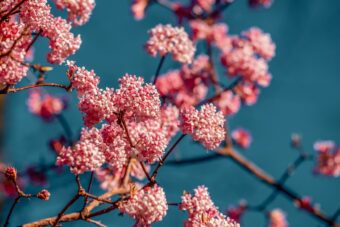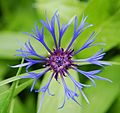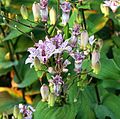In this article, we will be talking about plants that can be used to grow beside walls and fences in containers in the shade. As you can imagine this is a much more difficult area to have plants grow successfully, especially if you compare it to my article of growing beside walls and fences in containers in full sun.

When areas near tall vertical walls and fences do not make a natural home for plants, and few can tolerate the darkness and rainless growing conditions.
Apart from using plants that can survive in such areas, you have to increase your choices by offering more moisture. This can be done with a watering can or you may need to install an irrigation system (see my review of such a system).
If they are in deep shade, very few plants will survive but Lamiums, Tolmiea and some ferns will cope. Against a wall, Japanese quince will provide some wanted colour.
Remember under these conditions, you are looking for plants that do not need much water and can survive with limited light.
ACANTHUS MOLLIS (Bear Beeches)

This upright, 1.2m tall, semi-evergreen perennial with long, green, deeply-cut basal leaves. From these tall spikes of white, funnel-shaped, flowers that nestle between purple bracts appear in summer. Grow this dry compost tolerate plant in a well-drained, multipurpose compost in partial shade.
ACONITUM CARMICHAELII (Monk’s Hood)

This is a tall, 1.5m perennial that has mid-green, deeply-divided leaves and in autumn, spikes of hooded, lavender-blue flowers appear. Use it as a backdrop in your container display in a container full of well-drained, multipurpose compost.
ARUM ITALICUM subsp. ITALICUM

This short, 25cm tall, very attractive perennial is often grown for its large arrow-shaped, dark green, glossy leaves that appear from winter to spring, In early summer, yellow flowers appear that are soon followed by orange-red berries. ‘Marmoratum’ has attractive veining in its leaves. Grow it in a container full of well-drained, multipurpose compost.
CENTAUREA MONTANA (Perennial Cornflower)

This cottage garden favourite perennial has oval, tapering, hairy, green leaves, where in early summer thistle-like flowers of purple, blue, white or pink appear, Grow this spreading, 50cm tall perennial beside a wall in a moisture-retentive, multipurpose compost in a suitable container.
CHAENOMELES x SUPERBA (Japanese Quince)

This 1.5m tall, deciduous shrub has spiky branches of narrow, oval glossy, green leaves. In late spring it bears clusters of white, pink, orange or red, cup-shaped flowers appear whose shades depends on the variety that you have grown. Great trained on a wall or fence in a very large container full of well-drained, multipurpose compost.
DRYOPTERIS DILATATA (Broad Buckler Fern)

This 1m tall, deciduous or semi-evergreen fern has a rosette of arching fronds, with triangular to oval, serrated segments and dark brown stems. If you water well in the first growing season, it will tolerate dry compost very well. Grow it in a moisture-retentive, multipurpose compost in a container.
EPIMEDIUM PERRALDERIANUM (Barrenwort)

This 30cm short, semi-evergreen perennial has large, glossy, toothed, heart-shaped, dark green leaves. In spring, before the new foliage appears, small pendant bright yellow flowers are produced on wiry stems. Grow it as a ground cover plant in a container full of moisture-retentive, multipurpose compost where it will do well in deep shade,
LAMIUM GALEOBDOLON (Dead Nettles)

A 60cm tall, vigorous, mat-forming, evergreen perennial that has creeping green stems full of oval, silver-marked, dark green leaves. In summer, spikes of brown-spotted, yellow flowers appear. Grow this plant in a container full of well-drained, multipurpose compost.
An alternative is L. maculatum, which is a 15cm tall, semi-evergreen, mat-forming perennial that has white-green variegated leaves. In late spring to summer, spikes of white-headed flowers appear.
MACLEAYA MICROCARPA (Plume Poppy)

A 2.5m tall, upright perennial that has large, deeply –lobed, grey-green leaves, which are white underneath. In summer, this plant produces sprays of tiny, pink flowers on tall stems. Grow it in a large container full of well-drained, multipurpose compost near the back of container display in light shade.
NARCISSUS (Daffodil) ‘Actaea’

A 40cm tall, late-flowering perennial bulb that has narrow, grey-green leaves. In spring, white flowers with small, red-rimmed, yellow, cups appear. Plant in groups close to a fence or wall in a container full of well-drained, multipurpose compost.
PAEONIA DELAVAYI (Tree Peony)

This is a 2m tall, upright, deciduous shrub with deeply lobed, dark green leaves that are blue-green beneath. Grow this tall shrub next to a fence or wall in a container full of well-drained, multipurpose compost in a sheltered spot, where the dark red, nodding, cup-shaped flower that appear in spring can be appreciated.
PULMONARIA OFFICINALIS (Lungwort)

This 30cm tall, semi-evergreen perennial has pointed, oval, green leaves with white spots. In spring, clusters of funnel-shaped, pink, blue or white flowers appear. This is one tough plant that can take shade and lack of water. Grow it in a container full of well-drained, multipurpose compost.
SAXIFRAGA (Saxifrage) ‘Aureopunctata’

A 30cm tall, low growing perennial that forms rosettes of mid-green or dark green and yellow-variegated leaves. Masses of tiny, pink, star-shaped flowers appear in late spring to early summer. Grow it on front of container displays in a container full of well-drained, multipurpose compost.
TOLMIEA MENZIESII (Pick-A-Back Plant)

This is a 60cm tall, compact, semi-evergreen perennial that has ivy-shaped, textured. Green leaves, where in spring, tubular, nodding, green-yellow flowers appear. ‘Taff’s Gold’ had cream and green variegated leaves. Grow it in a container full of well-drained, multipurpose compost.
TRICYTRIS FORMOSANA (Toad Lily)

This 80cm tall, upright perennial has dark green leaves with purple-green spots on. From late summer to early autumn, purple-speckled white flowers appear. Grow this attractive plant in a container full of well-drained, multipurpose compost, where it will do well near a wall in full or partial shade.
UVULARIA GRANDIFLORA (Bellwort)

This 60cm tall, clump-forming perennial has green, lance-shaped leaves. In mid to late spring, yellow, bell-shaped flowers appear with slightly marked petals that are borne above slender stems. A useful plant for deep shade beside walls in a container full of well-drained, multipurpose compost.
VIBURNUM ACERIFOLIUM (Maple Leaf Viburnum)

A 2m tall, deciduous, upright shrub that has deep, green corrugated, jagged-edged leaves that turn orange, red and purple in autumn. In early summer, small, cream-white flowers clusters appear that are followed soon after by purple-black berries.
An alternative is Viburnum x bodnantense, which is a deciduous, upright shrub that has bronze leaves whilst young that turn dark green. Clusters of pink-white, sweet-smelling flowers appear along its bare branches from late autumn to early spring. ‘Dawn’ has beautiful dark pink flowering buds, which open to reveal pink flowers. Grow it in a large container full of well-drained, multipurpose compost, where they will reach a height of 3m.
CONCLUSIONS
In this article, we have discussed what plants can be grown near walls and fences in containers in the shade. As you can see, this is a demanding area to grow plants in.
They often get no sun, no water and no love, but if you look after them and supply some water then there is no reason why your plants will survive and flourish. Watering is a good reason to do this or otherwise, your container display will look lacklustre.
An area in shade does not mean that you cannot forego beautiful flowers or foliage, and you now know what plants can be used to help you make an informed decision.
If you have any questions or comments that you wish to make, please do so in the comment box below.
Stay out of the sun and grow these plants.

And now we can get some more for beside the shades. This is a good one really and all I can say is thank you. I understand that not all the plants will thrive well in the sun and it would be good to have some of the plants where there will be shade. I think it is usually very productive to learn from you because of the experience you have with this. Thanks.
Hi Jay
If you talk about one side of a coin, you must be able to talk about the other side, so that people do not feel left out. Finding plants that can grow in such a difficult growing condition can be really challenging and I hope you got a lot from this.
Best Wishes
Antonio
Your article is a reference manual for plants that can do well in those areas around that house that need them the most be have the worst growing conditions. We have attempted, in the past, to liven up front and back entrances with large overhangs using a variety of plants in containers. The only solution that we found were succulents. Your article has give us a huge variety to choose from. We can now enjoy plants as we enter our home on either side of the house.
Hi Anasrazja
It is good to extend what plants can be grown in containers in the shade by the side of fences and walls, which can be brutal to plants. I am glad that I have extended to your choice of what plants that can be grown here and hope you do add to your collections.
Kind regards
Antonio
.We have struggled to find colourful plants that work well in the shade.
Our front garden is small, mostly gravel, with 1 garden bed next to a fence and North facing so only gets sun briefly early morning and late afternoon. Sadly the plants don’t get the late afternoon sun as they are shielded by the fence on that side.
I do like the look of the Bear Beeches, Monks Hood and Japanese Quince, so will look out for those now when I next go to a garden centre. I assume they will be okay in soil too?
Thank you for sharing this post, I have found it very useful.
Hi Linda
What can be grown in a container can be grown in soil, but not all plants that grow in the soil can be grown in containers; you are much more limited. I am glad you now have a wider choice of what plants can be grown in the container by the side of fence and walls where the sun does not shine. I am glad you area adapting your garden to this growing condition.
Best wishes
Antonio